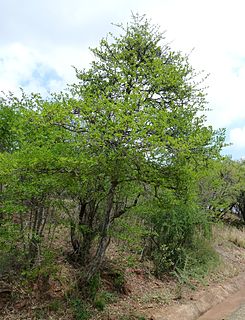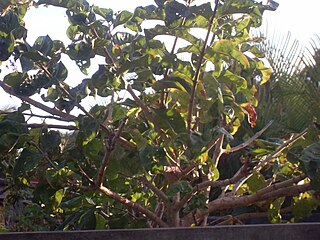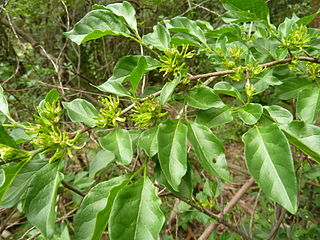
The Rubiaceae are a family of flowering plants, commonly known as the coffee, madder, or bedstraw family. It consists of terrestrial trees, shrubs, lianas, or herbs that are recognizable by simple, opposite leaves with interpetiolar stipules and sympetalous actinomorphic flowers. The family contains about 13,500 species in about 620 genera, which makes it the fourth-largest angiosperm family. Rubiaceae has a cosmopolitan distribution; however, the largest species diversity is concentrated in the tropics and subtropics. Economically important species include Coffea, the source of coffee, Cinchona, the source of the antimalarial alkaloid quinine, some dye plants, and ornamental cultivars.

Canthium is a genus of flowering plants in the family Rubiaceae. They are shrubs and small trees. The leaves are deciduous and the stems are usually thorny.
Afrocanthium keniense is a species of flowering plant in the family Rubiaceae. It is endemic to Kenya. It is threatened by habitat loss.
Vangueria schliebenii is a species of flowering plant in the family Rubiaceae. It is endemic to Tanzania.
Tapiphyllum was a genus of flowering plants in the family Rubiaceae but is no longer recognized. In 2005, a molecular phylogenetic study showed that the type species, Tapiphyllum cinerascens, is more closely related to Vangueria than to Tapiphyllum obtusifolium and Tapiphyllum velutinum. It is not clear whether the latter two species are really separate from Vangueria. All the species of Tapiphyllum have been sunk into synonymy with Vangueria.

Vangueria is a genus of flowering plants in the family Rubiaceae. The genus is named for Voa vanguer, as V. madagascariensis is known in Malagasy.

Vanguerieae is a tribe of flowering plants in the family Rubiaceae and contains about 640 species in 28 genera. It is one of the most species-rich groups within the family and it is distributed all over the Paleotropics.

Afrocanthium is a genus of flowering plants in the family Rubiaceae. It consists of deciduous, unarmed trees, and shrubs. They are native to East Africa, from Sudan and Ethiopia to South Africa.

Plectroniella is a monotypic genus of flowering plants in the family Rubiaceae. It was described by Walter Robyns in 1928. The genus contains only one species, i.e. Plectroniella armata, which is found in southern Mozambique and northeastern South Africa. The species is characterized by the presence of large spines and is morphologically similar to Canthium. In 2004, a molecular phylogenetic study showed that Plectroniella armata is related to Canthium ciliatum and the transfer of the genus to Canthium was suggested.

Meyna is a genus of flowering plants in the family Rubiaceae.

Vangueria madagascariensis, commonly known by the names Spanish-tamarind, tamarind-of-the-Indies, or voa vanga, is a species of flowering plant in the family Rubiaceae native to the African continent having edible fruit. It is the type species of the genus Vangueria and was described in 1791 by Johann Friedrich Gmelin.
Ancylanthos was a genus of flowering plants in the family Rubiaceae but is no longer recognized. It was originally described by René Louiche Desfontaines in 1818. In 2005, it was sunk into synonymy with Vangueria, based on a phylogenetic study of DNA sequences.

Pachystigma was a genus of flowering plants in the family Rubiaceae but is no longer recognized. In 2005, it was sunk into synonymy with Vangueria, based on a phylogenetic study of DNA sequences.
Vangueria venosa is a species of flowering plant in the family Rubiaceae. It is found in Mozambique, Eswatini and the former Transvaal region.

Gracilodes nysa is a species of moth in the family Erebidae. The species is found in Africa, from Uganda and Kenya to South Africa and on the islands of the Indian Ocean, in Mauritius, Réunion, Madagascar, Seychelles and Comores.
Vangueria cinerascens is a species of flowering plant in the family Rubiaceae. It is found from Tanzania to South Tropical Africa. The epithet is a Latin adjective meaning ash-coloured, referring to the indumentum on the leaves.
Vangueria cistifolia is a species of flowering plant in the family Rubiaceae. It is found in Angola and Zambia.
This page is based on this
Wikipedia article Text is available under the
CC BY-SA 4.0 license; additional terms may apply.
Images, videos and audio are available under their respective licenses.









